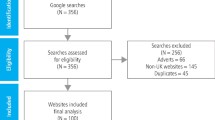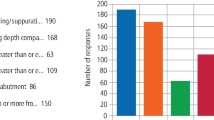Abstract
Introduction Dental implants are a popular option for replacing missing teeth. When searching for information regarding dental implants, patients may first look to their dental practice website. The aim of this study was to assess the variance of patient information provided regarding implant complications on dental implant practice websites.
Materials and methods Inclusion criteria for this study were dental practices within the Greater Glasgow & Clyde health board and practices with an active website. Completeness was assessed using a six-point score based on the British Association of Oral Surgeons 'Information for patients' leaflet and Association of Dental Implantology 'Considering dental implants? - A patient's guide to dental implant treatment' leaflet.
Results In total, 90.7% (n = 107) of practices provided accessible implant information on their websites. However, only 37.3% (n = 44) mentioned one or more specified dental implant complications. Pain/discomfort was the most frequently stated complication (n = 41/118); implant failure was only mentioned by 19 practices (16%). The mean number of complications mentioned by the 118 practices offering dental implants was 1.1.
Discussion As implant dentistry grows, there may be concerns over patient expectations. To overcome lack of quality assurance on the internet, dentists can provide factual information on their websites. They should be aware of their duty to provide material that is accurate, honest, informative and not potentially misleading.
Key points
-
Highlights a lack of standardisation of patient information provided by UK dental practice websites regarding suitability and complications of dental implants.
-
Reminds registrants that there is an increasing trend in patients seeking their own information regarding dental implants and other treatment options online.
-
Reminds registrants of their duty to provide material that is accurate, honest and informative, in line with the GDC's principles of ethical advertising.
This is a preview of subscription content, access via your institution
Access options
Subscribe to this journal
Receive 24 print issues and online access
$259.00 per year
only $10.79 per issue
Buy this article
- Purchase on Springer Link
- Instant access to full article PDF
Prices may be subject to local taxes which are calculated during checkout
Similar content being viewed by others
References
Hiscott G. The sky's the limit with implant dentistry. 2018. Available at https://www.dentistry.co.uk/2018/02/20/skys-limit-implant-dentistry/ (accessed April 2020).
PR Newswire. Global Dental Implants Market Insights, 2020-2025 - Increasing Popularity of Dental Tourism, Increasing Edentulous Patient Population. 2020. Available at https://www.prnewswire.com/news-releases/global-dental-implants-market-insights-2020-2025---increasing-popularity-of-dental-tourism-increasing-edentulous-patient-population-301005250.html (accessed April 2020).
Pjetursson B E, Karoussis I, Burgin W, Bragger U, Lang N P. Patients' satisfaction following implant therapy. A 10-year prospective cohort study. Clin Oral Implants Res 2005; 16: 185-193.
Nickenig H J, Wichmann M, Andreas S K, Eitner S. Oral health-related quality of life in partially edentulous patients: assessments before and after implant therapy. J Craniomaxillofac Surg 2008; 36: 477-480.
Hong D G K, Oh J H. Recent advances in dental implants. Maxillofac Plast Reconstr Surg 2017; 39: 33.
Gaviria L, Salcido J P, Guda T, Ong J L. Current trends in dental implants. J Korean Assoc Oral Maxillofac Surg 2014; 40: 50-60.
Leung K C M, McGrath C P J. Willingness to pay for implant therapy: a study of patient preference. Clin Oral Implants Res 2010; 21: 789-793.
Tricio J, Laohapand P, van Steenberghe D, Quirynen M, Naert I. Mechanical state assessment of the implant-bone continuum: A better understanding of the Periotest method. Int J Oral Maxillofac Implants 1995; 10: 43-49.
Association of Dental Implantology. Considering Dental Implants? A patient's guide to dental implant treatment. 2015. Available at https://consideringdentalimplants.co.uk/_userfiles/pages/files/consideringdentalimplants.pdf (accessed April 2020).
British Association of Oral Surgeons. Information for patients: dental implants. 2019. Available at https://www.baos.org.uk/wp-content/uploads/2019/03/Dental-Implants-final-.pdf (accessed April 2020).
The Supreme Court. Montgomery v Lanarkshire Health Board. 2015. Available online at https://www.supremecourt.uk/cases/uksc-2013-0136.html (accessed May 2021).
Ali S, Woodmason K, Patel N. The quality of online information regarding dental implants. Br Dent J 2014; 217: E16.
Kessels R. Patient's memory for medical information. J R Soc Med 2003; 96: 219-222.
Main B, Adair S. The changing face of informed consent. Br Dent J 2015; 219: 325-327.
Parvizi M, Talai N, Parvizi Z. Quality of healthcare information on the Internet: the case of Apicectomies. Oral Surg 2017; DOI: 10.1111/ors.12263.
Cobb R, Scotton W. Online information in orthognathic surgery. Oral Surg 2013; 6: 56-60.
Scottish Dental Practice Board. Primary Care Dentistry in Scotland: Annual Report 2018/19. 2019. Available at https://www.shsc.scot/media/61224/2019-11-26-sdpb-report.pdf (accessed April 2020).
Office for National Statistics. Internet access - households and individuals, Great Britain: 2018. 2018. Available at https://www.ons.gov.uk/peoplepopulationandcommunity/householdcharacteristics/homeinternetandsocialmediausage/bulletins/internetaccesshouseholdsandindividuals/2018 (accessed April 2020).
Statista Research Department. Share of individuals who have used the internet to search for health care information in the United Kingdom (UK) in 2015. 2015. Available online at https://www.statista.com/statistics/505053/individual-use-internet-for-health-information-search-united-kingdom-uk/ (accessed April 2020).
Chestnutt I, Reynolds K. Perceptions of how the Internet has impacted on dentistry. Br Dent J 2006; 200: 161-165.
Chen Y Y, Li C M, Liang J C, Tsai C C. Health Information Obtained from the Internet and Changes in Medical Decision Making: Questionnaire Development and Cross-Sectional Survey. J Med Internet Res 2018; DOI: 10.2196/jmir.9370.
Kwon J H, Kye S Y, Park E Y, Oh K H, Park K. What predicts the trust of online health information? Epidemiol Health 2015; DOI: 10.4178/epih/e2015030.
Nichols L C, Hassall D. Quality and content of dental practice websites. Br Dent J 2011;210: E11.
Joyal F. Making people want dentistry. J Calif Dent Assoc 1998; 26: 502-505.
Budd M, Davies M, Dewhurst R et al. Compliance of NHS dental practice websites in Wales before and after the introduction of the GDC document 'Principles of ethical advertising'. Br Dent J 2016; 220: 581-584.
Sbaffi L, Rowley J. Trust and Credibility in Web-Based Health Information: A Review and Agenda for Future Research. J Med Internet Res 2017; DOI: 10.2196/jmir.7579.
Jayaratne Y S N, Anderson N K, Zwahlen R A. Readability of websites containing information on dental implants. Clin Oral Implants Res 2014; 25: 1319-1324.
Leira-Feijoo Y, Ledesma-Ludi Y, Seoane-Romero J M, Blanco-Carrión J, Seoane J, Varela-Centelles P. Available web-based dental implants information for patients. How good is it? Clin Oral Implants Res 2015; 26: 1276-1280.
Addy L D, Uberoi J, Dubal R K, McAndrew R. Does your practice website need updating? Br Dent J 2005; 198: 259-260.
General Dental Council. Standards for the Dental Team. 2013. Available at https://standards.gdc-uk.org/Assets/pdf/Standards%20for%20the%20Dental%20Team.pdf (accessed May 2021).
General Dental Council. Principles of Ethical Advertising. 2012. Available at https://www.valident.co.uk/wp-content/uploads/2012/06/Ethical-advertising-statement-Jan-2012.pdf (accessed April 2020).
Lorenzo-Pouso A I, Pérez-Sayáns M, Kujan O et al. Patient-centered web-based information on oral lichen planus: Quality and readability. Med Oral Patol Oral Cir Bucal 2019; DOI: 10.4317/medoral.22992.
Leira Y, Castelo-Baz P, Pérez-Sayáns M, Blanco J, Lorenzo-Pouso A I. Available patient-centered Internet information on peri-implantitis. Can our patients understand it? Clin Oral Investig 2019; 23: 1569-1574.
Chan S, Tulloch E, Cooper E, Smith A, Wojcik W, Norman J. Montgomery and informed consent: where are we now? BMJ 2017; DOI: 10.1136/bmj.j2224.
Public Health England. Local action on health inequalities: Improving health literacy to reduce health inequalities. 2015. Available at https://assets.publishing.service.gov.uk/government/uploads/system/uploads/attachment_data/file/460709/4a_Health_Literacy-Full.pdf (accessed September 2020).
Acknowledgements
Ilyaas Rehman and Fatima Elmahgoub contributed equally to the manuscript.
Author information
Authors and Affiliations
Corresponding author
Ethics declarations
The authors declare no conflicts of interest.
Rights and permissions
About this article
Cite this article
Rehman, I., Elmahgoub, F. & Goodall, C. Evaluation of the information provided by UK dental practice websites regarding complications of dental implants. Br Dent J 230, 831–834 (2021). https://doi.org/10.1038/s41415-021-3080-2
Received:
Accepted:
Published:
Issue Date:
DOI: https://doi.org/10.1038/s41415-021-3080-2



